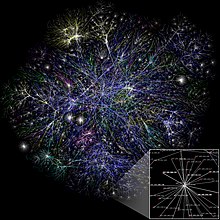Network mapping
An example of such an effort is the OPTE project, which is attempting to develop a system capable of mapping the internet in a single day.
Many of the vendors from the Notable network mappers list enable you to customize the maps and include your own labels, add un-discoverable items and background images.
Sophisticated mapping is used to help visualize the network and understand relationships between end devices and the transport layers that provide service.
There are three main techniques used for network mapping: SNMP based approaches, active probing and route analytics.
The SNMP based approach retrieves data from Router and Switch MIBs in order to build the network map.
The second works on the control plane and infers autonomous system connectivity based on BGP data.
This technique relies on various BGP collectors who collect routing updates and tables and provide this information publicly.
However, these paths do not necessarily reflect how data is actually forwarded and adjacencies between AS nodes only represent a policy relationship between them.
Nevertheless, support for this type of mapping is increasing as more and more ISP's offer to peer with public route collectors such as Route-Views and RIPE.
netTransformer allows us also to perform network diffs between any two dumps and thus to reason how does the BGP peering has evolved through the years.
